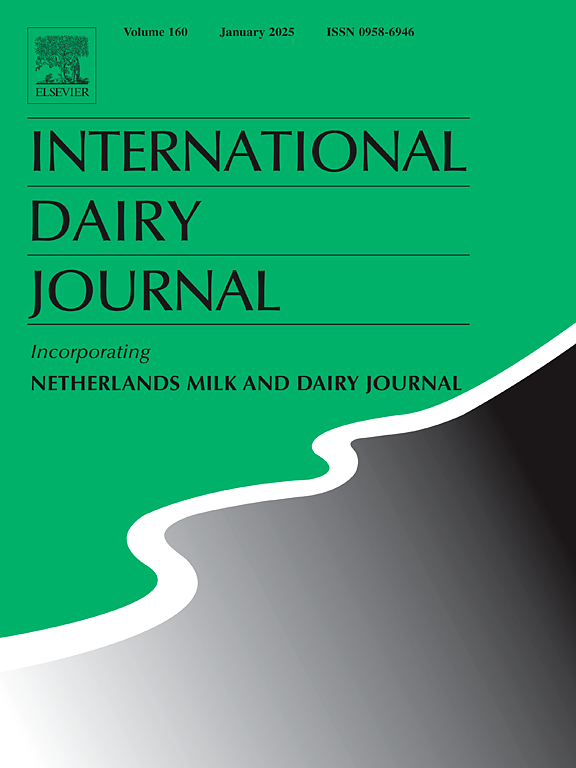Effect of including plantain in perennial ryegrass-white clover pasture offered to grazing dairy cows on milk composition and milk fatty acid and mineral concentrations
IF 3.4
3区 农林科学
Q2 FOOD SCIENCE & TECHNOLOGY
引用次数: 0
Abstract
This study explored the effect of including plantain (Plantago lanceolata L.; PL) in perennial ryegrass (Lolium perenne L.; PRG)-white clover (Trifolium repens L.; WC) pasture on the milk composition and milk fatty acid (FA) and mineral concentrations of spring-calving dairy cows. The treatments were PRG-WC (GrC) and PRG-WC-PL (GCP) pastures. Milk samples were obtained from dairy cows (n = 13 per treatment) during early (61 ± 12 d in milking; EL) and late (214 ± 16 d in milking; LL) lactation. Cows grazing GCP produced milk with a lower fat concentration. Milk lactose concentration was greater from cows grazing GCP in LL. Cows grazing GCP produced milk with greater concentrations of polyunsaturated FA (g 100 g milk−1) and α-linolenic acid (g 100 g milk fat−1). Treatment did not affect milk mineral concentrations in EL. In LL, cows grazing GCP produced milk with lower concentrations of calcium (−10 %) and magnesium (−7 %) compared with GrC. Including PL in a PRG-WC pasture for dairy cows can beneficially alter milk FA composition.
多年生黑麦草-白三叶草牧场添加车前草对放牧奶牛乳成分、乳脂肪酸和矿物质浓度的影响
本研究探讨了车前草(Plantago lanceolata L.;多年生黑麦草(Lolium perenne L.;PRG)-白三叶草(Trifolium repens L.;牧草对春产奶牛乳成分、乳脂肪酸和矿物质含量的影响。分别为PRG-WC (GrC)和PRG-WC- pl (GCP)牧场。在挤奶早期(61±12 d)采集奶牛的乳样(每个处理n = 13头);泌乳后期(214±16 d);)哺乳。吃GCP的奶牛产的奶脂肪含量较低。泌乳中乳糖含量较高的是采食GCP的奶牛。饲喂GCP的奶牛产奶中多不饱和脂肪酸(g 100 g奶−1)和α-亚麻酸(g 100 g乳脂−1)的含量更高。处理不影响EL中的乳矿物质浓度。在LL期,与GrC相比,放牧GCP的奶牛产奶量钙(- 10%)和镁(- 7%)浓度较低。在PRG-WC牧场中添加PL有利于改变牛奶中FA的组成。
本文章由计算机程序翻译,如有差异,请以英文原文为准。
求助全文
约1分钟内获得全文
求助全文
来源期刊

International Dairy Journal
工程技术-食品科技
CiteScore
6.50
自引率
9.70%
发文量
200
审稿时长
49 days
期刊介绍:
The International Dairy Journal publishes significant advancements in dairy science and technology in the form of research articles and critical reviews that are of relevance to the broader international dairy community. Within this scope, research on the science and technology of milk and dairy products and the nutritional and health aspects of dairy foods are included; the journal pays particular attention to applied research and its interface with the dairy industry.
The journal''s coverage includes the following, where directly applicable to dairy science and technology:
• Chemistry and physico-chemical properties of milk constituents
• Microbiology, food safety, enzymology, biotechnology
• Processing and engineering
• Emulsion science, food structure, and texture
• Raw material quality and effect on relevant products
• Flavour and off-flavour development
• Technological functionality and applications of dairy ingredients
• Sensory and consumer sciences
• Nutrition and substantiation of human health implications of milk components or dairy products
International Dairy Journal does not publish papers related to milk production, animal health and other aspects of on-farm milk production unless there is a clear relationship to dairy technology, human health or final product quality.
 求助内容:
求助内容: 应助结果提醒方式:
应助结果提醒方式:


